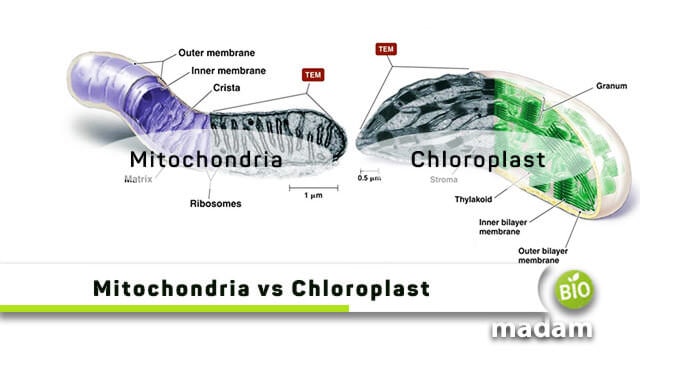Both mitochondria and chloroplast are the essential cells in living organisms that vitally run for them to live. While checking the difference between mitochondria and chloroplast, you will see that mitochondria utilize oxygen and other nutrients to produce a cell’s energy in terms of ATP. In contrast, chloroplast is the central unit of photosynthesis (a process in which plants utilize sunlight to produce energy-rich organic compounds as a food fuel for cells) in a plant cell.
We excluded this article to provide you with a detailed comparison between mitochondria and chloroplast, covering all their key similarities & dissimilarities. So, let’s begin with a brief comparison chart!
Comparison Chart
| Factors | Mitochondria | Chloroplast |
| Location | In all aerobic organisms, e.g., animals and plants. | Only present in green plants, protists, & a few green algae |
| Structure | Bean-shaped | Disc-shaped |
| Color | Colorless | Green color |
| Inner & Outer Chambers | Matrix & Cristae, respectively | Stroma & Thylakoids, respectively |
| Role of Oxygen | Utilizes oxygen | Releases oxygen |
| Pigments | No pigments found | Chlorophyll, Carotenoids, & Photosynthetic pigments |
| Energy Utilization | Releases energy in process | Stores energy in process |
Mitochondria – Brief Explanation

The main function of a mitochondrion is to produce and provide energy to the remaining parts in a plant or animal cell. In addition, they are mostly discovered from where ATPs (Adenosine Triphosphates) are made. This whole energy generation mechanism is processed by cellular respiration, which mainly requires food to continue. Mitochondria may vary in its number, depending on the cell type, as a medium-sized animal cell consists of more than 1000 of them.
Chloroplasts – Brief Explanation
On the other hand, chloroplasts are always found where photosynthesis takes place in plant cells (photoautotrophic organisms). It operates through its Chlorophyll unit, which further catches sunlight (light energy) to combine carbon dioxide (CO2) and water (H2O). Using the same light energy, they are converted to glucose, which Mitochondria additionally utilize to generate ATP. Therefore, chlorophyll a and b are the only responsible units in chloroplast to give it a green color.
Check Out the Similarities and Dissimilarities between Mitochondria and Chloroplast
A chloroplast is just like Mitochondria when it comes to a double-layer member of its cells. Both have several other parts inside their cell membranes, which we will discuss further. Let’s quickly look into the fundamental similarities between them.
Key Similarities
DNA & RNA
Both Mitochondria and Chloroplast have important genetic material called DNA (deoxyribonucleic acid) and RNA (ribonucleic acid).
Double Membrane Organelle
Both structures consist of double-layer membranes that are inner and outer layers.
Gives Energy
Mitochondria and Chloroplast have a similar role in providing energy to their respective cells.
Enzymes & Coenzymes
Another feature of both organelles has enzymes and coenzymes in them.
Involves O2 and CO2: Either it’s Mitochondria or Chloroplast, both utilize oxygen and carbon dioxide in their functioning.
Mobile Cells
Last but not least, both organelles can move within a living cell.
Key Dissimilarities
Despite being quite similar, there are many differences between Mitochondria and Chloroplast that are mentioned below.
General Information
Mitochondria
They are giant, membrane-bounded organelles in all types of eukaryotic (with a distinct nucleus) cells. Mitochondria are also known as the “Power House of a Cell.” Their primary function is to metabolize energy through the cellular respiration process.
Chloroplast
These organelles are primarily present in green plants and algae. A chloroplast is an active center of photosynthesis, which is relatively larger and more complex than a Mitochondrion cell.
Cell Shape & Location
Mitochondria
The mitochondrial cells are colorless organelles with a bean-like shape. They are mainly present in animal and plant cells, called aerobic organisms.
Chloroplast
In contrast, chloroplasts are naturally green in color and have a disc-like shape in the cell. Moreover, they are present in green plants, euglena, mosses, and a few algae.
Outer and Inner Chambers
Mitochondria
It consists of two main chambers, inner and outer, which are also called cristae and matrix. The inner mitochondrial membrane turns into projections, which are later called Cristae.
Chloroplast
On the other side, Chloroplast has two chambers, which are called stroma and thylakoids. Here the Thylakoids are the flattened sacs.
Functioning
Mitochondria
The chief purpose of the mitochondrial cell is to convert glucose to energy, called ATP. It utilizes oxygen, along with glucose to release energy and bring forth carbon dioxide and water later on. Mitochondria perform photorespiration, beta-oxidation, and oxidative phosphorylation.
Chloroplast
On the contrary, the basic units in the thylakoid membrane of a Chloroplast are chlorophyll, carotenoids, and photosynthetic pigments. The solar energy is stored in the chloroplast of plants, which is further used to release oxygen as well. Moreover, the organelle also consumes water and carbon dioxide to form glucose (sugar). Chloroplasts are the site for photosynthesis and photorespiration.
Final Verdict
After thoroughly reading the differences between Mitochondria and Chloroplast, we realized that both are, one after the other, the central contributing organelles to a living (eukaryotic) cell. They equally function for the growth of a cell.
Note that, Mitochondria are found in almost all eukaryotic cells, while Chloroplasts are only displayed in green plants and some algae to hold the process of photosynthesis in them.

Hello, I would like to introduce myself to you! I am Chelsea Rogers, an experienced blog writer for science articles, holding an MPhil degree. My enthusiasm to grab the best knowledge, let it relate to botany, zoology, or any other science branch. Read my articles & let me wait for your words s in the comment section.

